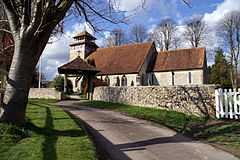Meonstoke
| Meonstoke | |
 St Andrew's church, Meonstoke |
|
 Meonstoke | |
| Population | 645 (parish)[1] |
|---|---|
| OS grid reference | SU612203 |
| Civil parish | Corhampton & Meonstoke |
| District | City of Winchester |
| Shire county | Hampshire |
| Region | South East |
| Country | England |
| Sovereign state | United Kingdom |
| Post town | WINCHESTER |
| Postcode district | SO32 |
| Dialling code | 01489 |
| Police | Hampshire |
| Fire | Hampshire |
| Ambulance | South Central |
| EU Parliament | South East England |
| UK Parliament | Meon Valley |
| Website | Corhampton & Meonstoke Parish Council |
Meonstoke is a village in Hampshire, England. Meonstoke lies in the Meon Valley where it cuts through the Middle Chalk of the South Downs. Old Winchester Hill is at the edge of the parish to the east.
It sits on the eastern bank of the River Meon. On the northern part of the western bank is Corhampton. The A32 crosses the river between the two villages, which have formed a single civil parish since 1932. On the southern part of the bank is Droxford. Soberton lies to the south of the parish, Hambledon to the east and Exton to the north.
History
Flint implements found near Old Winchester Hill suggest that the area that is now the parish of Meonstoke was inhabited over 20,000 years ago. Later, in neolithic times a roadway developed along the South Downs, passing south of Old Winchester Hill and crossing the River Meon at Exton. There is a Neolithic stone barrow on the southern slopes of Old Winchester Hill. Also on the Hill are eight Bronze Age barrows. Old Winchester Hill is the site of one of a chain of five Iron Age forts along the South Hampshire Ridgeway.[2]
There are few Roman remains in the Meon Valley, nut none in Meonstoke.[2]
The Meonwara, a Jutish tribe settled in the Meon Valley in the sixth century, but the stoke in the village’s name is of Anglo-Saxon origin.[2]
It is possible that Borough English or Ultimogeniture the tradition of inheritance by the last-born of a parent's estate, which was recorded in the village as late as 1801, began with the Meonwara.[2]
Menestoche is mentioned in The Domesday Book, with 28 heads of families listed, suggesting a possible population of 140.[2]
In the thirteen century, Meonstoke was granted a weekly Market, suggesting the importance of the village at the time.[2]
The church of St Andrew mainly dates from the 13th century, with a later tower, probably 15th century with early 20th century repairs.[3] These included the addition in 1906 of a memorial window by Mary Lowndes, a leading light in the Arts and Crafts Movement.[4]
A church was mentioned in the Domesday Book, but the first mention of a rector is found in 1262. Rectors of the parish have included: Thomas Chaundler, Christopher Bainbridge, Lawrence Humphrey, John Harris and Laurence Henry Woolmer.
A national school was built in the village in 1842.
The former Meon Valley Railway passed to the east of the village but the planned station and yard at Meonstoke were never built. The route is now the Meon Valley Railway Line Trail, which can be joined here.
The singer/songwriter Frank Turner comes from Meonstoke.[5] He mentions the area in his song "To Take You Home" on the album Love Ire & Song.
Bucks Head Hill, Meonstoke
References
- ↑ "Parish Headcounts, Area: Corhampton & Meonstoke CP". Neighbourhood Statistics. Office for National Statistics. 2001. Retrieved 2008-03-29.
- ↑ 2.0 2.1 2.2 2.3 2.4 2.5 Collins FB and Hurst JC Meonstoke and Soberton Winton Publications, Winchester, 1978
- ↑ William Page (editor) (1908). "Parishes: Meonstoke". A History of the County of Hampshire: Volume 3, pp. 254-257. Victoria County History. Retrieved 2008-03-29.
- ↑ Chris Maxse (2004). "St Andrew's, Meonstoke". Retrieved 201108-04-06.
- ↑ "Music - Frank Turner". BBC. Retrieved 2012-05-08.
External links
| Wikimedia Commons has media related to Meonstoke. |

